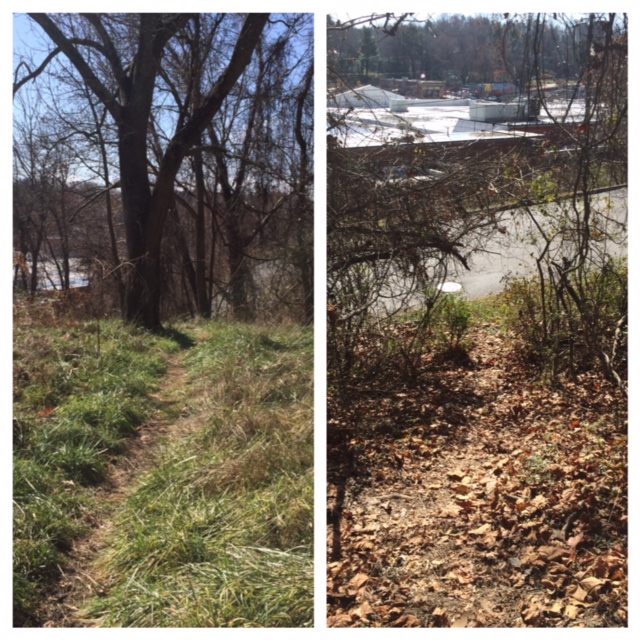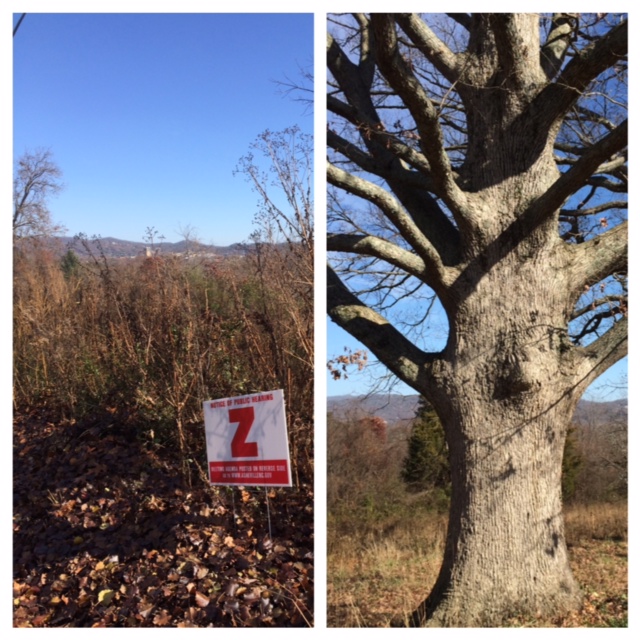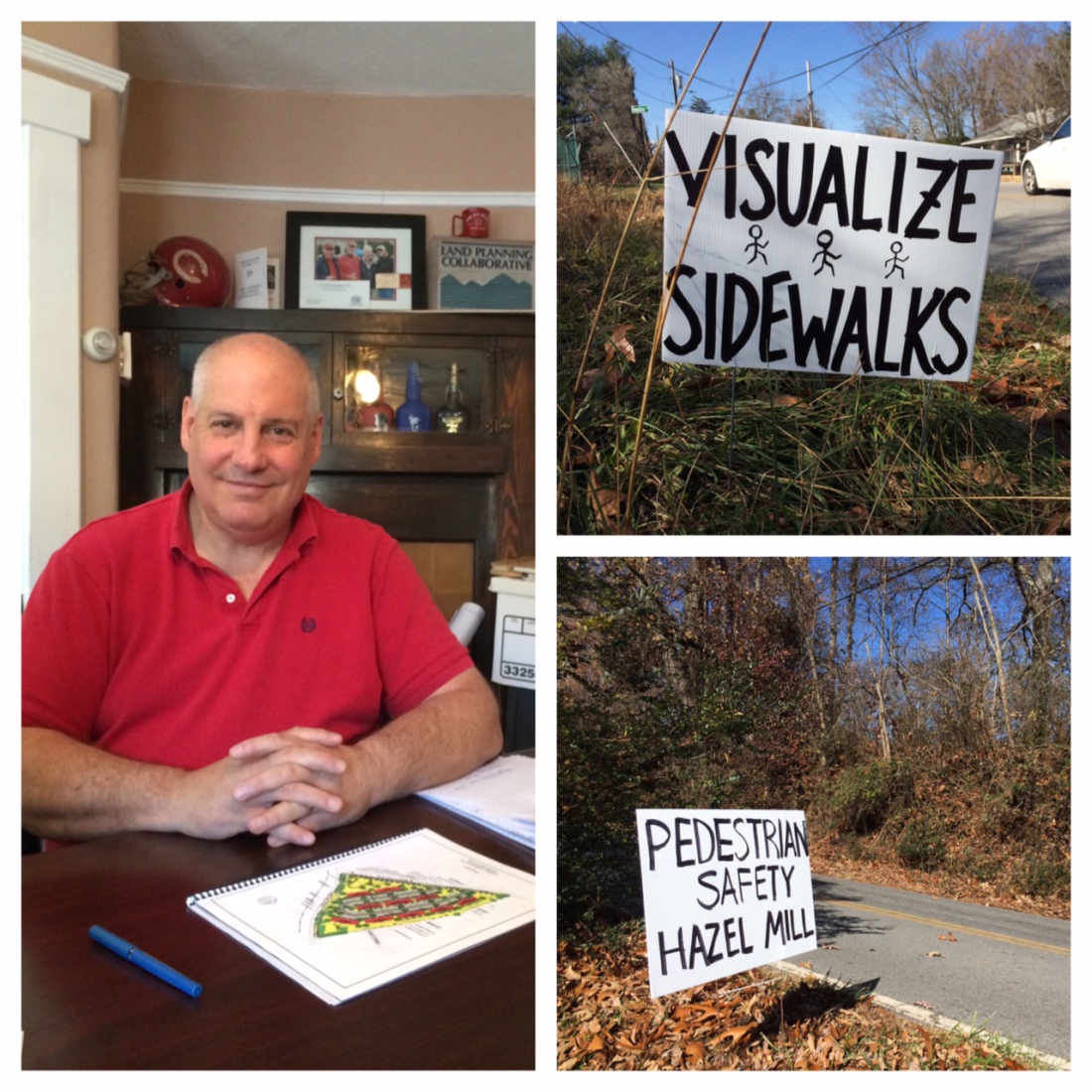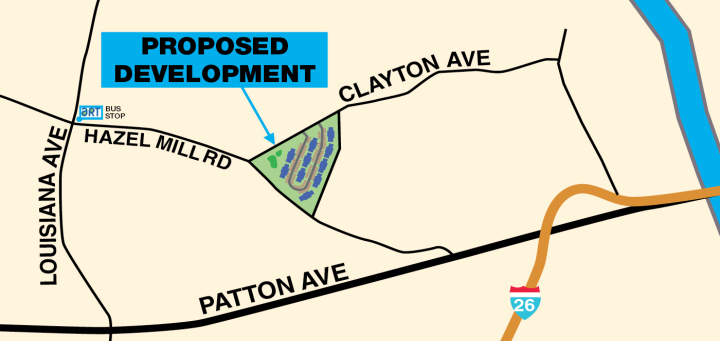The billowing local debates over affordable housing and pedestrian safety are pivoting toward a long overlooked section of West Asheville.
A proposal for a major new apartment complex at the corner of Hazel Mill Road and Clayton Avenue just north of Patton Avenue is steering the discussion. Developer Bob Grasso is asking Asheville City Council for a zoning change that would allow him to build 104 apartments on the 6.5-acre site — about double the number that would be allowed under the land’s current zoning designation.
Earlier this year, national research firm RealtyTrac found that Asheville is suffering from one of the worst affordable housing crises in the country. And in recent months, city officials have discussed a number of actions to change that, from increasing housing incentives to a broad zoning overhaul encouraging density.
Grasso is pitching his White Oak Grove Apartments project as part of the solution, touting plans to include 11 units that fit the city’s definition of affordable housing. Those one-bedroom apartments would go for $819 per month, he says. The other 93 apartments would meet the city’s requirements for “workforce housing.” That translates to rents of $905 to $1,000 for 21 one-bedroom apartments and rents of $1,075 to $1,200 for 72 two-bedroom apartments, he says.
In order to offer those prices and maintain the profitability of the project, Grasso says he needs to be able to build on a larger scale than is currently allowed on the property.
“I’m not trying to compete with all the high-end stuff going up in the south end,” Grasso says. “I’m not going to have a swimming pool and all that. What I’m going to have is good housing for teachers. I’m trying to do something that is going to meet the needs of the community as well as produce retirement income for me.”
However, neighborhood activists say the area already suffers from a severe lack of transportation infrastructure and can’t handle such an influx of new residents without major improvements. Drivers frequently break Hazel Mill’s 30 mph speed limit as they veer off Patton Avenue to avoid traffic lights, driving toward Louisiana Avenue, Leicester Highway and other points west. During rush hours, the winding corridor is often congested, and there are no sidewalks in sight.
“Hazel Mill is an extremely dangerous road,” says neighborhood resident Valerie Martin. “It’s extremely narrow. There’s no sidewalks or bike lanes. … It’s a delicate area — everyone’s concerned about the increase in traffic.”
Grasso has been pitching different iterations of the development for several years. And in that time, Martin has helped organize the neighborhood against it, turning in several petitions with hundreds of signatures asking the city to block the proposal. In 2012, Grasso withdrew his zoning request from City Council only minutes before a vote, worrying he didn’t have enough support. But he’s made a number of changes since then, and now even Martin admits that she’s encountering more support for the project from Council.
Still, the neighborhood continues to rally against the plan, mounting new petition drives and lining the road with yard signs urging “pedestrian safety on Hazel Mill.”
“What we’re asking them to do is improve the infrastructure even before they consider approving that density increase,” Martin says. “We’re begging for something that will mitigate the traffic. We understand the importance of affordable housing. We understand that the city is desperate to check this off of their list. [But] we feel that we’re already pretty high density. Doubling our density is more than what most people in the community want.”
Canary in the coal mine
One of main appeals of the neighborhood is its close proximity to downtown Asheville, the River Arts District, the Haywood Road corridor and the conveniences of Patton Avenue. However, unlike many other neighborhoods so close to those thriving sections of the city, Hazel Mill residents have little practical way of getting to them without a vehicle.
Lacking sidewalks, residents have carved “goat trails” down the steep slope to the south of Hazel Mill through peoples’ yards in order to access the Sav-Mor on Patton Avenue. Rachel Reeser, a neighborhood resident for seven years, says she’s seen an uptick in people trespassing in her yard to get to the grocery store over the years. She speculates that many of them don’t seem to have other means of transportation, noting that the neighborhood is home to trailer parks, a Section 8 housing development and other low-income residencies.

Grasso says he’ll give all of his renters yearly bus passes. However, the bus stop nearest to his proposed development is about 3,000 feet up Hazel Mill, at the corner of Louisiana Avenue. Joe Minicozzi, who used to live in the neighborhood and currently serves on the Asheville Planning and Zoning Commission, says he sees the disconnect as a major problem. The commission is tasked with making recommendations to City Council, and Minicozzi cast the only vote against the White Oak Grove rezoning when the issue came before the non-binding body on Oct. 16.
“People will get killed walking up that street,” he asserts. “So handing them a bus pass is basically incentivizing them to a path of suicide.” Earlier this year, a N.C. Department of Transportation report found that Asheville is the most dangerous city in the state, per capita, for people on foot.
Previously the executive director of the Asheville Downtown Association, Minicozzi now works as a planning consultant, advising cities across the U.S. on development issues. The roots of the current debate actually stretch back nearly a century, he says, owing to the fact that the city incorporated neighborhoods to the south of Patton Avenue decades before the Hazel Mill area. The Haywood corridor benefited from the city’s early investment in planning and infrastructure, he says, but because sections of the Hazel Mill and Emma neighborhoods weren’t annexed until 1989, they still haven’t received equal attention and resources.
“We never as a city went back in to do those things that are necessary for city-making, which is providing a connective network, increasing services like sidewalks and things like that,” says Minicozzi. “It’s a problem that there’s only two streets going through that whole quadrant of our city and that one road [Hazel Mill] is having to shoulder the burden of all that traffic.
“It’s like having one vein handle your entire leg,” he says. “That’s the bigger picture.”
In the longterm, Minicozzi says he wants the city to craft a comprehensive plan for the area rather than deal with development proposals on a piecemeal basis. For now, he agrees with residents that more sidewalks are needed to prevent injuries if the development goes through.
“The canary in the coal mine, to a pedestrian environment, is the sidewalk,” he says. “I don’t think you can find a person on the planet who thinks Hazel Mill is a safe street to walk in.”
Whose responsibility is it?
A longtime local landscape architect, Grasso wants to build a 10-foot wide sidewalk and bike path bordering the development, buttressed from Hazel Mill traffic with a median. His plan calls for expanding Clayton Avenue onto his property enough to allow on-street parking without impeding traffic on the small, two-lane road. The development includes outdoor picnic grounds, a dog park (for apartment residents only) and several environmental features, such as permeable pavement to minimize water runoff. And he’d include a bike rack capable of parking up to 40 two-wheelers.

Grasso agrees with neighborhood activists that the problem, however, is that even with his infrastructure, it leaves roughly half-mile stretches of Hazel Mill without sidewalks to get to the Louisiana bus stop or Patton Avenue. He’s pledged $10,000 to the city to aid the connection efforts, but due to the challenging terrain, those missing stretches of sidewalk are likely to cost more than $100,000. That level of funding “is the city’s responsibility,” Grasso says. “I’m doing it on my property. … I can’t spend $100,000. There’s no way.”
Although he hasn’t calculated the figures, Grasso estimates that the long-term increase in property-tax revenue the apartments would generate would more than pay for the cost of city sidewalks. City Council is scheduled to consider his zoning request Dec. 9, and he says he’ll be prepared with the tax estimates by then. “I’m probably going to make that plea on behalf of the neighborhood,” he says. “Without this project coming to Council, they wouldn’t have had much of a voice as far as getting sidewalks on Hazel Mill.”
Grasso also agrees that speeding is already a problem on Hazel Mill, but says a traffic study he commissioned shows that the impact of his development would be “negligible.” He estimates the apartment complex would result in about 57 additional cars using the road during the peak afternoon rush hour. To help remedy the situation, he supports city traffic-calming measures such as speed bumps or stop signs at the intersection of Clayton and Hazel Mill, near the development’s entrance.
“I’ve tried to respond to what the community concerns have been,” he says.
Balancing great needs
Constructing sidewalks or bike lanes on Hazel Mill and adjacent streets doesn’t register on the city’s Pedestrian and Bicycle Master plans, which prioritize a long list of other areas for building infrastructure.
But City Council Member Chris Pelly says he doesn’t want neighborhoods like Hazel Mill to be overlooked as the city focuses resources on so-called “innovation districts” like Charlotte Street and the River Arts area. With a developer willing to invest millions in Hazel Mill, he says it’s fair for it to jump to the top of the priority list. “We can’t just tell the neighborhood, ‘Wait for five or 10 years,’” he says. “That’s not going to work, in my book.”
Pelly won election in 2011 after mounting a successful neighborhood campaign to build sidewalks in East Asheville.
“Part of where I’m coming from philosophically is, we’re prepared to spend $30 million in the River Arts District to encourage high-density development there,” he explains. “If that’s what’s happening in residential neighborhoods, I think we have to be equally willing to use at least a fraction of that to make some improvements in those types of areas as well. Of course, the challenge is, where is the money coming from.”

Council members have been meeting with Grasso, neighborhood residents and transportation department officials to assess the situation ahead of their Dec. 9 decision.
If 5 percent of neighborhood residents who own property adjoining the White Oak proposal file a formal petition with the city, it will require a supermajority of City Council to approve the zoning request. It’s a petition threshold Martin says they’re likely to achieve, noting that neighbors filed such a petition in 2012. That means only two Council members would need to vote “no” to block the development.
In an email to neighborhood residents, Mayor Esther Manheimer says the city continues to analyze the situation. “There is a great need for housing in the city and it’s difficult to meet that challenge while balancing all other factors,” she writes. “But, the council is committed to both adding much needed housing and improving the city’s multimodal transportation infrastructure.”
For his part, Pelly says that if sidewalks extending from the development aren’t “part of the mix, I don’t know how I’m going to vote on this, even though it contributes to our affordable-housing solutions. It has to be part of a more comprehensive response.
“It’s not a perfect world but this is an opportunity here,” he says. “I don’t know what will carry the day.”
Asheville City Council plans to hold a public hearing on the White Oak Grove Apartments rezoning request Tuesday, Dec. 9, in room 209 of City Hall. The meeting begins at 5 p.m. Stay tuned to mountainx.com/news/local-government for updates.







Good luck neighbors for City enforcement of parking requirements. I live besides the Woods off Coleman Ave. That apartment complex sits on 11 acres. Zoning regulations require 2 spaces for each apartment. But somehow the owner gets by without providing that for his tenants. If they don’t have a ‘sticker” they will be towed. The owner sends them over to our very crowded street to park. This regularly brings strangers into our neighborhood, takes up street parking that the people on our street need. The City know all about this , but allows it to fester. They will do the same in this new complex down the road.
Sounds like the city could at least add another bus stop. This is another example of the city annexing neighborhoods and giving those folks a big tax hike without providing commensurate services and benefits to those taxpayers.
Sidewalks to where ? Does anyone know anyone who has walked across that nearby stretch of Patton Avenue?
No way to add a bus stop without changing a bus route. The sidewalk to the bus stop is a logical project, and probably the sidewalk to Patton as well. With the new sidewalks on Patton there will be more pedestrian traffic there over time. Like Chris Pelly, unless we have the votes for the sidewalk, I won’t vote for this project.
How will the GoogleCar figure into this? Anyway, what’s the protocol for the City making infrastructure improvements for some developers, but refusing development to happen at all if other developers don’t provide the infrastructure that the City should be providing? I guess Mr. Grasso hasn’t greased enough palms. So now we have Gordon and Gwen voting NO on the RAD apartments which only provided 5% affordable housing (Cecil, Chris, Jan, Marc, and da Mayor voting yes) and now Cecil and Chris are going to vote NO on this development which offers workforce housing and 10% affordable.
Amusing per GoogleCar. You will be blown away by how fast that one happens.
And each project has its particulars. So, we do what we can to provide fair incentives, and etc.
Yeah, I’m sure the insurance industries will hash that out in a hurry (GoogleCar) and I graciously accept that answer as each project is indeed unique with no real way put simple parameters around them, but, I kinda think when a developer gives up land, space, dirt, real estate, what have you, the City should be willing, in fact quite pleased, to pony up for surrounding civic improvements that won’t have a chance to get done any other way.
Hey, look what we just did!
This is NOT affordable housing.
I live adjacent to this property. Hazel Mill Road, which is narrow and windy, was not designed for the traffic it currently receives, and will be even more dangerous if this apartment complex is built. Also, there are no sidewalks in this area, making it impossible to safely walk to bus stops, stores, or downtown. And, only 10% of the units (11) are classified affordable, though I don’t know anyone in the working class who can afford $819/month in rent. This property is currently zoned RM8 (Grasso wants the property rezoned to RM16 to double the density). 54 units could be built on the property the way it is currently zoned. Why not build some nice homes?
This is NOT affordable housing.
This isn’t affordable. So far this ‘workforce housing ‘ idea has not been executed well here. I have been working on homelessness and poverty issues for close to 2 decades, and have yet to see ideas like this really reach those who need it. I couldn’t afford $819/ month on my own and I have a great work history and bachelors degree. The supposed affordable housing put up by MHO is incredibly exclusionary and downright discriminatory in my experience. (Trying to get clients of mine better housing). I hate that people are patting themselves on the back for creating ‘affordable and workforce housing’ when the working class can’t afford to live there! Or if they can, and they have mediocre credit and a criminal charge they can be excluded automatically. There is a lot of housing discrimination in this town, and with the impending changes with the housing authority, it’s going to get worse. What a mess.